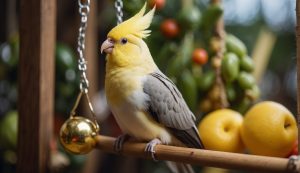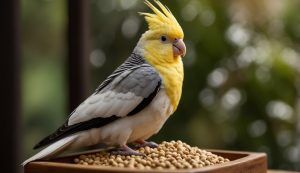How Much Attention Do Cockatiels Need? Understanding Your Feathered Friend’s Social Requirements

Cockatiels have skyrocketed in popularity as companions due to their friendly demeanor and the joy they bring to households with their vocal abilities. Recognized for their social nature, these birds thrive on interaction and engagement.
As a bird enthusiast and cockatiel owner, I’ve observed that these feathered friends require a substantial amount of attention to maintain their mental and emotional well-being.
The level of attention needed can vary widely among individual birds, but all cockatiels benefit from daily interaction and stimulation.

Ensuring that your cockatiel has a diverse and stimulating environment is crucial. Their inquisitive minds and active bodies call for an assortment of toys and activities that can mimic the complexity of their natural habitat. In my experience, the establishment of a consistent daily routine including feeding, playtime, and training helps in preventing behavioral problems that can arise from boredom or neglect.
Key Points
- Cockatiels are social pets that require daily interaction.
- A stimulating environment is key to their well-being.
- Consistency in daily care can prevent behavioral issues.
Table of Contents
Understanding Cockatiel Behavior and Social Needs
In my experience, cockatiels are highly social birds that thrive on interaction. They exhibit a range of behaviors indicating their need for companionship and attention.
Social Interaction Essentials
Cockatiels are naturally gregarious, often found in flocks in the wild, which translates to a need for social interaction in a home environment. I’ve noticed they are friendly and social birds, seeking engagement through sound and movement. Regular interaction with their human caregivers or bird companions is crucial to prevent feelings of loneliness. They express their social nature through vocalizations, mimicking sounds, and engaging in mutual preening when they have formed a bond. For cockatiels, social interaction isn’t just a preference; it’s a requirement for their emotional well-being.
- Daily Interaction: At least 1-2 hours of direct interaction.
- Signs of Attention-Seeking: Vocal calls, tapping on the cage, or playful movements.
The Importance of Companionship
Having a companion, whether it’s another cockatiel or a human, can fulfill their social needs and reduce the risk of loneliness. When I pair cockatiels together, I find they often form a mate bond and engage in behaviors conducive to their collective well-being, like feeding each other and nestling together. If you’re a single cockatiel owner like myself, it’s crucial to provide ample attention and interaction each day. Investing time in building a relationship with my cockatiel ensures its happiness and mental health.
- Companion Preferences: In a pair or small flock. Human companionship can also suffice when ample attention is given.
- Bonding Activities: Sharing food, gentle petting, and interactive play.
My cockatiels have shown me that understanding and meeting their social needs are vital aspects of their care.
Creating a Stimulating Environment

In my experience, a stimulating environment is crucial for keeping my cockatiel happy and healthy. Here’s how I set up my bird’s home and playtime to ensure they have plenty of excitement and activity.
The Right Cage Setup
I always make sure my cockatiel’s cage is spacious enough to allow for free movement and exercise. It’s vital to provide ample space for them to flap their wings, climb, and play. My ideal cage setup includes:
- Perches of varying thickness: This helps keep their feet healthy and encourages natural climbing behavior.
- A cuttlebone or mineral block: These provide essential nutrients and a means for my cockatiel to forage and sharpen its beak.
- Safe, bird-friendly materials: I avoid anything with small, detachable parts or toxic substances that could harm my feathered friend.
Toys and Activities
Toys and activities are an integral part of my cockatiel’s life, aiding in mental and physical stimulation. Here’s what I incorporate:
- Foraging toys: They mimic the wild behavior of searching for food, keeping my cockatiel’s mind engaged.
- Chewable items: Such as soft wood or shreddable toys, which are essential for beak health and also provide a fun activity.
- Interactive toys: Like mirrors or bells that appeal to their natural curiosity and love for sounds.
I always rotate the toys to ensure my cockatiel stays interested and excited by the novelty. Regular playtime outside the cage is also part of our routine, which gives my bird the necessary exercise and bonding time with me. By attending to these aspects, I create a stimulating environment that promotes a healthy, content, and lively cockatiel.
Daily Care and Routine

When I look after my cockatiel, I focus on providing a balanced diet, quality time for bonding, and proper health and grooming care daily. These aspects are crucial for their overall well-being and happiness.
Balanced Diet and Nutrition
Every morning, I make sure my cockatiel has fresh water and a variety of foods to cover their nutritional needs. My cockatiel’s diet primarily consists of high-quality pellets, which should constitute about 60-70% of their intake. I supplement this with:
- Fruits: Small portions of apple or berries.
- Leafy Greens: A few leaves of spinach or kale.
I keep treats to a minimum and ensure all fresh foods are washed to prevent contamination.
Bonding and Interaction Time
My afternoons are usually reserved for some quality time with my feathered friend. Cockatiels crave companionship and can become distressed without daily interaction. I spend at least 20-30 minutes engaging with my pet bird through:
- Talking and Whistling: It helps to strengthen our bond.
- Interactive Play: Simple games using bird-safe toys.
This routine helps establish trust and prevents behavioral issues related to loneliness.
Health and Grooming
Lastly, I take a few minutes each day to inspect my cockatiel for any signs of poor health or distress. Grooming is also an essential part of their care and includes:
- Feather Maintenance: Gently misting with warm water encourages natural preening.
- Nail Trims: As needed, to keep them from getting too long.
Regular health check-ups with a vet help maintain my cockatiel’s health, preventing and addressing problems quickly.
Potential Behavioral Issues and Solutions

Caring for a cockatiel involves understanding their social and behavioral needs. I must ensure their well-being by addressing issues promptly and positively guiding their behavior.
Identifying and Reducing Stress
To keep my cockatiel content, I need to recognize signs of stress which can manifest as feather plucking or shrill, repetitive screaming. To alleviate stress, I focus on creating a soothing environment—dimming lights if it’s too bright and ensuring a consistent routine. Interaction is crucial; I spend quality time engaging with my cockatiel daily to prevent boredom and reduce anxiety.
- Regular Interaction: Engage in daily play and training to bond and reduce stress.
- Environment: Keep their living space comfortable, safe, and enriched with toys.
Training and Managing Unwanted Behaviors
Training is vital to manage behaviors such as destructive chewing or unwanted screaming. Through positive reinforcement, I reward good behavior which makes training an enjoyable experience for my cockatiel. If an unwanted behavior occurs, my response is to remove attention briefly, teaching the cockatiel that such actions won’t elicit a reaction. Consistency is key in training sessions, which keeps the rules clear and strengthens our bond.
- Positive Reinforcement: Use treats or praise to reward desired behaviors.
- Consistent Training: Set aside time each day for training to enforce rules and build trust.
Frequently Asked Questions

In my experience with pet birds, it’s important to understand the commitment that comes with a cockatiel – from diet and habitat setup to social interaction and health care. Let me share some specific insights that might help.
What are the dietary needs for a healthy cockatiel?
For my cockatiel, I provide a balanced diet that includes high-quality cockatiel pellets, fresh fruits, vegetables, and occasional seeds as treats. It’s crucial to avoid avocado and chocolate, as they’re toxic to birds.
How do you properly set up a cockatiel cage?
When I set up my cockatiel’s cage, I ensure it’s large enough for them to spread their wings and includes perches at different heights, as well as toys for mental stimulation. The cage should be placed in a safe, interactive part of my home.
What are some essential tips for beginner cockatiel care?
As a beginner, I learned quickly that providing a routine, keeping the cage clean, and being gentle and patient are key to a happy cockatiel. Monitoring its health and behavior regularly is also paramount.
How much daily interaction do cockatiels typically require?
I spend at least an hour daily interacting with my cockatiel, as they are social creatures that thrive on attention and engagement. This can include talking, training, or simply being in the same room.
What is the average lifespan of a cockatiel?
I know that with proper care, a cockatiel can live on average between 15 and 20 years. Some even live longer with exceptional care and luck!
How often should a cockatiel be allowed out of its cage?
I make a point to allow my cockatiel out of its cage daily in a safe, enclosed space for exercise and exploration. This doesn’t just promote good physical health but also aids their emotional well-being.











